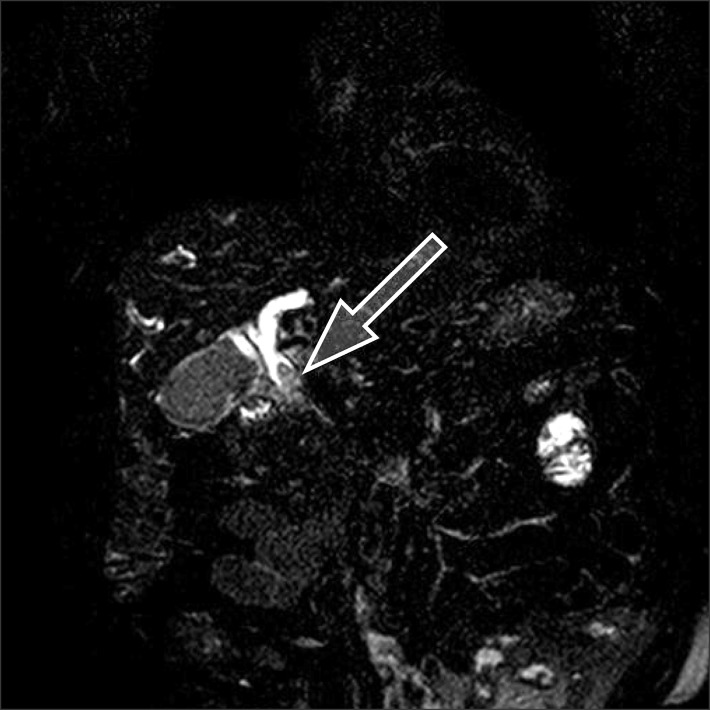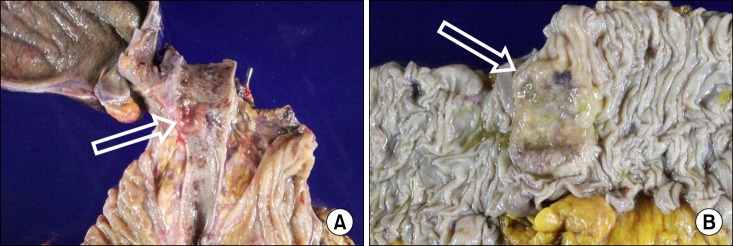Korean J Hepatobiliary Pancreat Surg.
2015 Aug;19(3):125-128. 10.14701/kjhbps.2015.19.3.125.
Metastatic mucinous adenocarcinoma of the distal common bile duct, from transverse colon cancer presenting as obstructive jaundice
- Affiliations
-
- 1Department of Surgery, SMG-SNU Boramae Medical Center, Seoul National University College of Medicine, Seoul, Korea. ahnyj@brm.co.kr
- KMID: 2043289
- DOI: http://doi.org/10.14701/kjhbps.2015.19.3.125
Abstract
- The patient was a 70-year-old male whose chief complaints were obstructive jaundice and weight loss. Abdominal imaging studies showed a 2.5 cm sized mass at the distal common bile duct, which was suggestive of bile duct cancer. Eccentric enhancing wall thickening in the transverse colon was also shown, suggesting concomitant colon cancer. A colonoscopy revealed a lumen-encircling ulcerofungating mass in the transverse colon, that was pathologically proven to be adenocarcinoma. The bile duct pathology was also adenocarcinoma. Pylorus-preserving pancreaticoduodenectomy and extended right hemicolectomy were performed under the diagnosis of double primary cancers. Postoperative histopathologic examination revealed moderately differentiated mucinous adenocarcinoma of transverse colon cancer, and mucinous adenocarcinoma of the distal common bile duct. Immunohistochemical staining studies showed that the bile duct cancer had metastasized from the colon cancer. The patient recovered uneventfully from surgery and will be undergoing chemotherapy for three months.
Keyword
MeSH Terms
Figure
Reference
-
1. Smith HJ. Extrahepatic bile duct obstruction in primary carcinoma of the lung: incidence, diagnosis, and non-operative treatment. J Natl Med Assoc. 1980; 72:215–220. PMID: 6248647.2. Moon SG, Han JK, Kim TK, Kim AY, Kim TJ, Choi BI. Biliary obstruction in metastatic disease: thin-section helical CT findings. Abdom Imaging. 2003; 28:45–52. PMID: 12483383.
Article3. Lee YJ, Kim SH, Lee JY, Kim MA, Lee JM, Han JK, et al. Differential CT features of intraductal biliary metastasis and double primary intraductal polypoid cholangiocarcinoma in patients with a history of extrabiliary malignancy. AJR Am J Roentgenol. 2009; 193:1061–1069. PMID: 19770330.
Article4. Park JS, Huh JW, Park YA, Cho YB, Yun SH, Kim HC, et al. Prognostic comparison between mucinous and nonmucinous adenocarcinoma in colorectal cancer. Medicine (Baltimore). 2015; 94:e658. PMID: 25881840.
Article5. Popp JW Jr, Schapiro RH, Warshaw AL. Extrahepatic biliary obstruction caused by metastatic breast carcinoma. Ann Intern Med. 1979; 91:568–571. PMID: 484956.
Article6. Maruyama K, Gunvén P, Okabayashi K, Sasako M, Kinoshita T. Lymph node metastases of gastric cancer. General pattern in 1931 patients. Ann Surg. 1989; 210:596–602. PMID: 2818028.7. Thomas JH, Pierce GE, Karlin C, Hermreck AS, MacArthur RI. Extrahepatic biliary obstruction secondary to metastatic cancer. Am J Surg. 1981; 142:770–773. PMID: 7316046.
Article8. Papachristou D, Fortner JG. Biliary obstruction after gastrectomy for carcinoma of the stomach. Surg Gynecol Obstet. 1978; 147:401–404. PMID: 98852.9. Riopel MA, Klimstra DS, Godellas CV, Blumgart LH, Westra WH. Intrabiliary growth of metastatic colonic adenocarcinoma: a pattern of intrahepatic spread easily confused with primary neoplasia of the biliary tract. Am J Surg Pathol. 1997; 21:1030–1036. PMID: 9298879.10. Lim JH, Park CK. Pathology of cholangiocarcinoma. Abdom Imaging. 2004; 29:540–547. PMID: 15383897.
Article11. Colagrande S, Batignani G, Messerini L, Pinzani M. Intrabiliary metastasis from rectal cancer mimicking peripheral papillary-type cholangiocarcinoma. J Hepatol. 2004; 41:172–174. PMID: 15246230.
Article12. Jain R, Fischer S, Serra S, Chetty R. The use of Cytokeratin 19 (CK19) immunohistochemistry in lesions of the pancreas, gastrointestinal tract, and liver. Appl Immunohistochem Mol Morphol. 2010; 18:9–15. PMID: 19956064.
Article
- Full Text Links
- Actions
-
Cited
- CITED
-
- Close
- Share
- Similar articles
-
- Metastatic Common Bile Duct Cancer from Pulmonary Adenocarcinoma Presenting as Obstructive Jaundice
- A Common Bile Duct Web Presenting with Obstructive Jaundice without Common Bile Duct Stone
- Obstructive Jaundice
- Photodynamic Therapy Followed by Left Hepatectomy Used to Treat an Intraductal Papillary Mucinous Neoplasm of the Bile Duct
- A case of obstructive jaundice due to limy bile in the cystic and common bile ducts





